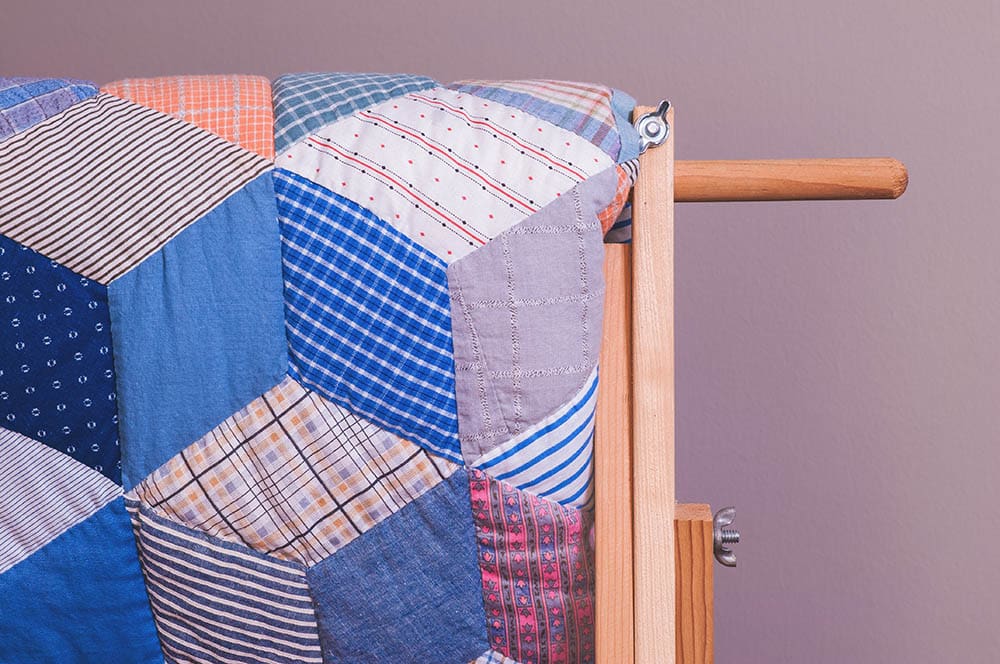How to Hang a Quilt – 12 Expert Tips
-

- Last updated:

Whether you’ve got a stunning quilt as a family heirloom or you enjoy turning your hand scrap quilting, the bed isn’t the only place you can display quilts. They can make stunning, effective wall art, but they’re also heavy, need a lot of space, and must be hung properly to ensure they stay up. And if you’ve got cats that like to scratch or climb, then you may need to consider an alternative way to display your blankets.
If you do have the space, the quilts, and the inclination, below are 12 expert tips on how to hang a quilt.

How to Hang a Quilt
1. Get Help
Unless you’re hanging a small quilt or blanket and can use a standard or handmade picture frame, you are likely going to need help with the hanging. Quilts are heavy, and if you try hanging one corner before letting go and moving to the next corner, it could cause the quilt to rip or the hanging mount to pull away from the wall. With two people, the process is easier and less likely to cause damage.

2. Use Hanging Rods
A hanging rod is essentially a dowel rod, typically made of wood but also available in other materials including metal. The rod connects to the wall at the top where the quilt will be displayed. The quilt is attached via hanging sleeves, tabs, or triangle corners.
Rods are beneficial because they allow you to spread the weight of the quilt right across its width and they allow for a variety of ways to hang and display the quilt, but you do need to ensure that the rod is hung securely from the wall.
3. Velcro Hanging
Velcro hanging strips may not be suitable for very heavy quilts or certain types of wallpaper and paint. They have an adhesive back, which attaches to the wall, and then a hook and loop fastening.
Measure the width of the quilt, put Velcro on the wall where the top corners of the quilt will sit, and then add additional Velcro strips every few inches to spread the weight. With Velcro strips, you can remove the quilt easily for cleaning and to let it stretch out.

4. Mounted Quilts
Mounting a quilt or a panel that will never make its way onto a finished quilt is a quick and easy method of display. It also helps protect the quilt itself if you use a frame with a glass cover, but framing is not an option for large quilts because they are too heavy and too cumbersome. A glass cover can prevent you from being able to clearly see the stitching, but it does protect against dust and dirt.
5. Use Hand-Crafted Frames
You don’t have to use store-bought picture frames; if you do have small panels that you want to display, you could even make your own hand-crafted frames. Making your own frame means choosing a material that perfectly complements the quilt, and it allows you to be as creative as you want with the design.

6. Ensure Balanced Support
Whatever hanging method you use, ensure that the weight of the quilt is evenly distributed, ideally right along the top of the display. With a small quilt, using hangers in the top corners might be enough, but even in these cases, adding a hanger in the middle will allow for better weight distribution that places less pressure on the corners and the wall behind.
7. Make Sure There’s Room
You won’t usually want to fill an entire wall with a quilt, although it is possible to make this design work in some rooms. Ensure that the quilt won’t completely dominate the area where it is hung by choosing a large open wall space. If you have young children and pets, you will also want to ensure that the quilt is hung so that it isn’t easily reached from the floor or, for example, from the top of a cat tree.

8. Make the Colors Pop
If you’re looking to display a quilt, it means that you want to show it off, and this means that you will want to avoid hanging a quilt on a similarly-colored wall. Make the colors pop by choosing a quilt and wall combination that contrast with one another.
9. Avoid Natural Sunlight
Natural light is usually best for viewing anything, but while it might give a good view of a hung quilt, it will also cause the quilt to fade over time. Avoid hanging quilts in a position where they will be bathed in sunlight all day. If you want to ensure that the quilt is well-lit, you can always install a ceiling spotlight or a display light and choose a natural light.

10. Avoid Hot and Cold Areas
It isn’t just sunlight and pets that can damage your hung quilts, either. Extreme heat and extreme cold can also have a detrimental effect so don’t hang your quilt on a sunroom wall or directly above a radiator. Colors face, stitches disintegrate, and you could end up spending a lot of time picking your quilt up from the floor.
11. Let It Rest
Take your hung quilt down every 6 months or so and give it time to rest. A hung quilt is hunt tight and this can cause pressure on the stitching that eventually causes the stitches to break. If you have more than one quilt to display, consider rotating them so that they get 6 months on the wall and 6 months of rest. Alternatively, take your quilt down for a couple of weeks every 6 months.

12. Vacuum Your Quilt
Unless you have a delicate, antique quilt, or blanket that is very fragile, you should be fine to vacuum the quilt regularly. Vacuuming will help remove dust and debris, keep the quilt clean, and ensure it looks its best. Vacuum gently and consider taking the quilt down to vacuum it if you’re worried about pulling the display away from the wall.

Conclusion
Hanging quilts is a great way to show off your quilting skills or to display a particularly attractive quilt that you’ve bought or inherited. It can make a real statement piece for the wall while also letting you take greater advantage of the quilt itself.
Choose the best hanging method, get help to physically hang it, and ensure that you keep the quilt out of the way of sunlight and extreme temperatures to ensure longevity and maintain good looks. The quilt will also benefit from regular vacuuming and occasional resting.
Featured Image Credit: Four Oaks Crafts
Contents
